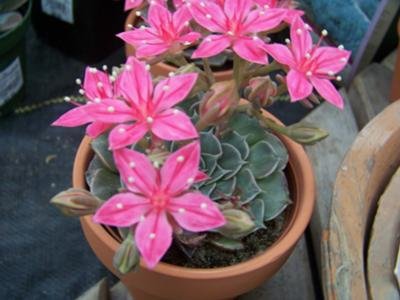When we think of succulents we generally think of their leaves as being their major contribution to the garden. In many cases you would be right as many succulents have small or insignificant flowers or take a long time to flower – the century plant gets its name for a good reason! However many succulents do have interesting flowers and are worth considering if flowers are important to you. I consider flowers on a succulent to be an added bonus. Most of my succulents were chosen for the leaf shape, texture and colour; the form of the plant and their hardiness. But over the years I have taken note of the ones that flower and I am very happy to have this bonus!
source
One of the best to put on a floral display is Cotyledon orbiculata. Those who know me will think "oh surely she’s not raving about that plant again!" Since I discovered this plant growing by the side of a lonely road and took some cuttings home with me, I have been more and more impressed with its various qualities. The large spoon shaped silvery leaves form on sprawling clumps about 75cm X 75cm. They strike easily from cuttings and after about 18 months each clump will put on a summer floral display that the birds adore. Bunches of bell-shaped, dusky apricot-coloured flowers are borne on tall (50cm) stalks and last for weeks and weeks. Cotyledon macrantha has bigger green leaves with reddish margins and similar flowers although more orange or orange-red in colour.
Members of the cactus family often have blooms of show stopping proportions. You may have heard of the Queen-of-the-Night Hylocereus undatus, which produces huge fragrant white flowers that open at night, closing as the sun rises in the morning. A little less spectacular and certainly easier to view (as it flowers throughout the day) is Echinocereus scheeri ssp. gentryi. I acquired this plant on the strength of its curious columnar form and purplish colour. Then it produced these amazing lipstick pink flowers in one magic flush, that had me ringing all my friends to tell them to come and look. They only lasted a week but wow it was an amazing sight!
Crassula falcata and C. perfoliata produce dramatic bunches of tiny red flowers which contrast well with their grey leaves. C. ‘Springtime’ is a very unassuming looking plant with fat triangular-shaped grey-green leaves squashed one on top of each other – until it blooms. Then the plant is covered in bunches of small cerise-pink flowers which last for months. Most echeverias produce their characteristic ‘shepherd’s hook’ flowers on a stem during spring and summer. These flowers are long lasting and usually in shades of pink, red, yellow or orange. Houseleeks (Sempervivum sp.) produce their flowers from the centre of their rosettes. The rosette elongates to unfold a head of starry flowers in shades of yellow, white, red or purplish pink. The entire rosette then dies, but hopefully not before producing lots of offsets!
Agaves and furcraeas can spend decades growing before producing enormous candelabra-like flower spikes several metres in height, after which the plant dies (presumably because it has exhausted itself!). To see one of these plants in flower is an amazing sight although be warned, all the flowers are capable of setting seed and forming aerial plantlets which take root as soon as they fall to the ground. The parent plant will also form a large number of offsets before it dies, so you could end up being well and truly inundated! The ever-popular Agave attenuata differs, in that it produces a curious drooping flower spike that reminds me of a fox’s tail!
The ponytail palm Beaucarnea recurvata is an unusual succulent from southern USA, Mexico and Guatemala. Its swollen base is a form of water storage and the grass-like leaves burst from the top like hair from a girl’s ponytail. Once these plants have matured, they produce large panicles of tiny white flowers, which mature into creamy or pinky-coloured seeds. This plant would make an excellent small hardy specimen tree in any frost-free garden and be a real talking point when it eventually flowered.
The aloes are another group of succulents with dramatic, long lasting and often vibrant flowers. Throughout a nursery I recently visited, the tall fiery spires of Aloe arborescens X ferox were putting on a fabulous display. The New Holland honeyeaters and eastern spinebills were having a marvellous time drinking the nectar from the flowers. Aeoniums are prized for their perfect rosettes of foliage on long stems, but their flowering is rarely mentioned. My Aeonium ‘Schwarzkopf’ occasionally produces conical heads of small yellow flowers, which contrast well with the black leaves.
The herbaceous sedums are a group of succulents recently popularised more for their flowers than their foliage. Sedum ‘Autumn Joy’ started the trend and now there are many of these hardy plants available. They bloom in late summer just as many other flowers are beginning to wane and are a valuable contribution to the garden.

Cuanta belleza. Es fascinante cuan hermosa es una suculenta pero no es comparable a cuando florea. Gracias.